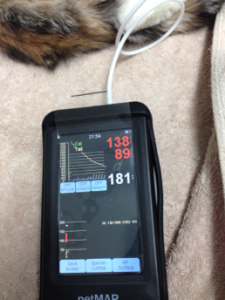

In people, high blood pressure is called “the silent killer” because usually you don’t know you have it unless it is picked up through routine measurements taken at your doctor’s office.
Pets too can suffer from both high and low blood pressure, which can be a marker of underlying disease. Measuring the blood pressure in our pets can be a bit more difficult than in humans. Not only do we have to deal with “white coat syndrome” where animals are more stressed when they are in our consultation rooms, but they can struggle, not lie still, shift position, tremble, etc. making it difficult to get any reading in the first place.
For these reasons, taking a pet’s blood pressure isn’t done as routinely as with humans, but it can be a very helpful test in some pets who hace been diagnosed with certain diseases or who are presenting with certain symptoms.
Monitoring blood pressure in animals under anaesthetic is also very useful for safety.
There are two main methods of measuring blood pressure. The most accurate measure is the direct method. This involves inserting a device into a major artery (usually the femoral artery). This is a very invasive procedure and is usually only practical in an emergency hospital setting with a critical patient who is under anaesthetic. The indirect methods of measuring blood pressure either use a sensor that detect the pulse pressure differences in an artery or measure using ultrasonic waves.
Many factors such as position of the animal, movement, stress, and trembling can all influence the blood pressure. This is why it is important to try to measure blood pressure in a quiet room, with your pet in a comfortable but standardised position, ideally with the owner present and calm veterinary staff attending.
Even so, for a reliable number we need to take several readings and possibly eliminate excessively high or low readings before averaging the results. A normal systolic blood pressure is around 110-160 mm Hg, and a normal diastolic blood pressure is around 60-90 mm Hg. The Mean Arterial Pressure (calculated through a formula or automatically calculated by some blood pressure machines such as the PetMAP) should be around 85-120 mm Hg.
A mildly elevated blood pressure could still be stress related and sometimes repeat measurements are needed.
Hypertension, or high blood pressure in our pets is usually caused by an underlying disease. Sometimes high blood pressure itself can cause further complications in our pets, such as sudden vision loss, nose bleeds, left-sided heart enlargement or (worsening) kidney disease.
In cats the two most important diseases that lead to high blood pressure are an overactive thyroid gland (hyperthyroidism) and chronic renal (kidney) failure.
Other disease processes that can result in high blood pressure are Cushing’s disease, Diabetes Mellitus, and glomerular (kidney) disease, as well as less common diseases such as acromegaly, polycythemia and pheochromocytoma, certain cancers or brain diseases.
Hypotension, or low blood pressure, can be the result of three possible mechanisms: a reduced amount of blood pumped around by the heart, a reduced blood volume present, or a reduced blood vessel tone.
Underlying causes for these issues could be heart disease, such as cardiomyopathy, where the heart muscle doesn’t contract and pump properly anymore, or diseases with severe dehydration such as Addison’s disease, severe vomiting and diarrhoea, burns, severe bleeding, spinal cord trauma, sepsis, anaphylaxis or drug overdoses (for example certain heart or blood pressure medication).
Low blood pressure can lead to inadequate blood supply and oxygen supply of critical organs such as the brain and kidneys, and can be very serious. Symptoms of hypotension can be weakness, depression, lethargy, confusion, fainting, and signs of kidney failure. Investigation of underlying causes and treatment is critical to diagnose underlying issues and move towards treatment.
High-risk groups for hypertension, such as dogs diagnosed with Cushing’s disease or cats with renal failure and/or hyperthyroidism, are recommended to have their blood pressure monitored regularly. They should also have monitoring and management of their underlying disease. If elevated blood pressure persists, further treatments may be needed. This could include special diets, weight control, and medications aimed at lowering blood pressure.
If you have any concerns regarding the health of your pet or believe that they may be experiencing abnormal blood pressure, please don’t hesitate to contact Cronulla Vet Clinic for advice on 02 9527 2604.
